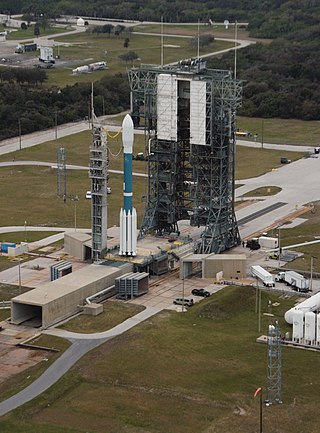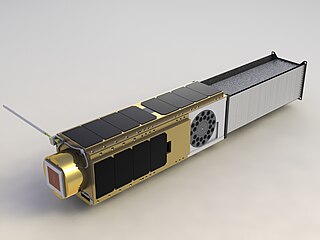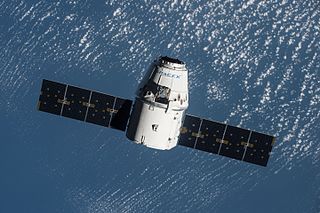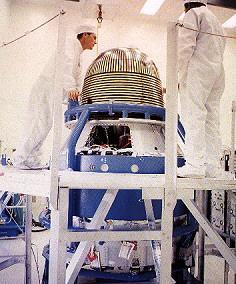
Cape Canaveral Space Force Station (CCSFS) is an installation of the United States Space Force's Space Launch Delta 45, located on Cape Canaveral in Brevard County, Florida.

Animals in space originally served to test the survivability of spaceflight, before human spaceflights were attempted. Later, many species were flown to investigate various biological processes and the effects microgravity and space flight might have on them. Bioastronautics is an area of bioengineering research that spans the study and support of life in space. To date, seven national space programs have flown non-human animals into space: the United States, Soviet Union, France, Argentina, China, Japan and Iran.

Delta IV was a group of five expendable launch systems in the Delta rocket family. It flew 45 missions from 2002 to 2024. Originally designed by Boeing's Defense, Space and Security division for the Evolved Expendable Launch Vehicle (EELV) program, the Delta IV became a United Launch Alliance (ULA) product in 2006. The Delta IV was primarily a launch vehicle for United States Air Force (USAF) military payloads, but was also used to launch a number of United States government non-military payloads and a single commercial satellite.

Pegasus is an air-launched multistage rocket developed by Orbital Sciences Corporation (OSC) and later built and launched by Northrop Grumman. Pegasus is the world's first privately developed orbital launch vehicle. Capable of carrying small payloads of up to 443 kg (977 lb) into low Earth orbit, Pegasus first flew in 1990 and remained active as of 2021. The vehicle consists of three solid propellant stages and an optional monopropellant fourth stage. Pegasus is released from its carrier aircraft at approximately 12,000 m (39,000 ft) using a first stage wing and a tail to provide lift and altitude control while in the atmosphere. The first stage does not have a thrust vector control (TVC) system.
The Mars Gravity Biosatellite was a project initiated as a competition between universities in 2001 by the Mars Society. The aim was to build a spacecraft concept to study the effects of Mars-level gravity (~0.38g) on mammals.

United Launch Alliance, LLC (ULA) is an American launch service provider formed in December 2006 as a joint venture between Lockheed Martin Space and Boeing Defense, Space & Security. The company designs, assembles, sells and launches rockets, but the company subcontracts out the production of rocket engines and solid rocket boosters.

The Bion satellites, also named Biocosmos, is a series of Soviet biosatellites focused on space medicine.

A bio satellite is an artificial satellite designed to carry plants or animals in outer space. They are used to research the effects of space on biological matter while in orbit around a celestial body. The first satellite carrying an animal was Soviet Sputnik 2 on November 3, 1957. On August 20, 1960 Soviet Sputnik 5 launched and recovered dogs from Earth orbit.

Space Launch Complex 37 (SLC-37), previously Launch Complex 37 (LC-37), is a launch complex on Cape Canaveral Space Force Station, Florida. Construction began in 1959 and the site was accepted by NASA to support the Saturn I program in 1963. The complex consists of two launch pads. LC-37A has never been used, but LC-37B launched uncrewed Saturn I flights and was modified and launched Saturn IB flights, including the first (uncrewed) test of the Apollo Lunar Module in space. It was deactivated in 1972. In 2001 it was modified as the launch site for Delta IV, a launch system operated by United Launch Alliance.

Space Launch Complex 17 (SLC-17), previously designated Launch Complex 17 (LC-17), was a launch site at Cape Canaveral Air Force Station (CCAFS), Florida used for Thor and Delta launch vehicles launches between 1958 and 2011.

Several significant events in spaceflight occurred in 2009, including Iran conducting its first indigenous orbital launch, the first Swiss satellite being launched and New Zealand launching its first sounding rocket. The H-IIB and Naro-1 rockets conducted maiden flights, whilst the Tsyklon-3, Falcon 1 and Ariane 5GS were retired from service. The permanent crew of the International Space Station increased from three to six in May, and in the last few months of the year, Japan's first resupply mission to the outpost, HTV-1, was conducted successfully.

The year 2010 saw a number of notable events in worldwide spaceflight activities. These included the first test flight of the SpaceX Dragon commercial resupply spacecraft, which is intended to resupply the International Space Station (ISS), and the maiden flights of the Falcon 9 and Minotaur IV rockets. In June 2010, South Korea conducted a second Naro-1 launch, after the failure of the rocket's maiden flight in 2009; however, the second attempt also failed. The Kosmos-3M was retired from service, making its final flight in April. The Molniya-M was also retired from service, making its final flight in September.

The O/OREOS is a NASA automated CubeSat nanosatellite laboratory approximately the size of a loaf of bread that contains two separate astrobiology experiments on board. Developed by the Small Spacecraft Division at NASA Ames Research Center, the spacecraft was successfully launched as a secondary payload on STP-S26 led by the Space Test Program of the United States Air Force on a Minotaur IV launch vehicle from Kodiak Island, Alaska on 20 November 2010, at 01:25:00 UTC.

OTV-2 was the first flight of the second Boeing X-37B, an American unmanned robotic vertical-takeoff, horizontal-landing spaceplane. It was launched aboard an Atlas V rocket from Cape Canaveral on 5 March 2011, and landed at Vandenberg Air Force Base on 16 June 2012. It operated in low Earth orbit. Its USA-226 mission designation is part of the USA series.

SpaceX CRS-9, also known as SpX-9, is a Commercial Resupply Service mission to the International Space Station which launched on 18 July 2016. The mission was contracted by NASA and is operated by SpaceX using a Dragon capsule.

BioSentinel is a lowcost CubeSat spacecraft on a astrobiology mission that will use budding yeast to detect, measure, and compare the impact of deep space radiation on DNA repair over long time beyond low Earth orbit.

Biosatellite 1, also known as Biosat 1 and Biosatellite A, was the first mission in NASA's Biosatellite program. It was launched on December 14, 1966, by a Delta G rocket from Launch Complex 17A of the Cape Canaveral Air Force Station into an orbit with a 296-kilometre (184 mi) perigee, 309-kilometre (192 mi) apogee, and 33.5 degrees of orbital inclination, with a period of 90.5 minutes.

Biosatellite 2, also known as Biosat 2 or Biosatellite B, was the second mission in NASA's Biosatellite program for biological research. It was launched on September 7, 1967, by a Delta G rocket from Cape Canaveral Air Force Station in Florida.

Biosatellite 3, also known as Biosat 3 and Biosatellite D, was a third and final mission in the Biosatellite program. It was launched on a Delta-N rocket from Cape Canaveral Air Force Station on June 29, 1969,





















